An outbreak of unknown viral infection began with a cluster of cases complaining severe respiratory symptoms in Wuhan, Hubei, China, during the end of the year 2019. Soon, the causing organism was identified, as novel coronavirus. The virus was named as Severe Acute Respiratory Syndrome-2 (SARS-CoV-2) and the disease caused by it as Coronavirus Disease 2019 (COVID-19). Then, COVID-19 has been considered a global pandemic by the WHO on 11 March, 2020 [1,2].
No consensus on a certain drug therapy for COVID-19 infection has been documented up until now. Currently, many drugs are under clinical trials or empirically included in treatment protocols for COVID-19. Drug repurposing is the most widely used method for rapid response in the face of this pandemic [1]. Trials to invent new medicines might not be feasible is short course of time. Nevertheless, there is a need to protect personnel in close contact with the patients.
One of such drug trials was through use of ivermectin, a previously Food and Drug Administration (FDA)-approved drug [3]. Currently, it is under scrutiny for its role in management of COVID-19 in different clinical trials worldwide. As of now, there are more than 36 clinical trials registered all over the world to investigate its role; the authors have two of them [4]. Moreover, ivermectin has been previously approved for management of Onchocerca volvulus and lymphatic filariasis [5]. It is known to have a wide-spectrum antiviral activity against a number of viruses under in vitro investigations [6-9]. Ivermectin has been shown to inhibit the nuclear import of viral proteins.
Moreover, it has been demonstrated to limit infection caused by some Ribonucleic Acid (RNA) viruses including influenza, dengue and West Nile viruses. In an in vitro study, ivermectin was found to be an inhibitor of the SARS-CoV-2, with a single addition to Vero/ hSLAM cells 2 hour post infection and able to effect ~5000-fold reduction in viral RNA at 48 hour [3,10]. Moreover, some senior experienced doctors have suggested that ivermectin could be an effective chemoprophylaxis and therapeutic for management of novel coronavirus disease due to its antiviral properties [11].
The rate of secondary attack of SARS-CoV-2 is high among family members in close contact especially the household (about 10-15%) [12]. Social distancing, isolation, and infection control measures are of paramount importance, but might be insufficient.
To the best of our knowledge, no reports worldwide studied the possible effects of ivermectin in pre- or post-exposure prophylaxis against SARS-CoV-2. Therefore, the aim of this study was to evaluate possible role of oral ivermectin as a post-exposure chemoprophylactic drug in asymptomatic family members in close contact with COVID-19 patients.
Materials and Methods
The current study was a prospective community-based, interventional randomised open label-controlled investigation; registered at clinicaltrials.gov with number NCT04422561. Chest physicians contributing in this work were responsible for simultaneous randomisation and follow-up of participants, as they diagnosed and referred the index cases. It was carried out at the faculty of Medicine, Zagazig University, Egypt; the period from June 1 to July 28, 2020. The study has been approved by the Institutional Research Board (IRB) of Zagazig Faculty of Medicine under the code: 6150-31-5-2020. A written informed consent was obtained from all participants in the study. A consent was also obtained from the legal guardian of participant/s aged below 18 years.
Asymptomatic household family members in close contact with cases of COVID-19 diagnosed and confirmed by Reverse Transcription-Polymerase Chain Reaction (RT-PCR) at Zagazig University Hospitals (ZUH), different triage and isolation hospitals were engaged in the study. They were interviewed regarding medical history, symptoms and co-morbidities. Body temperature was measured before enrollment to ensure that they were afebrile. It was planned to include contacts of 50 RT-PCR confirmed COVID-19 patients in each arm. But during recruitment and as the trial was non-blinded, the high protective efficacy detected for ivermectin made the researchers to stop prematurely the non-intervention arm.
Inclusion criteria: The study included asymptomatic household close contacts to confirmed RT-PCR COVID-19 index case, with age equal to or more than 16 years, and signed informed consent.
Exclusion criteria: Any contact developed symptoms or diagnosed as COVID-19 before enrollment, index case, failure to follow-up contacts for 14 days, and failure to document the index case when there was more than one case in a family.
Two arms (or groups) were designed according to use of ivermectin as follows: Group one (ivermectin group) contacts received ivermectin on the day of the diagnosis of their index case. It was given as one dose on empty stomach at day one (diagnosis day), repeated once more at day 3 (total 2 doses). The dose was adjusted according to Body Weight (BW) as follows: 15 mg/day for subjects of 40-60 kg BW; 18 mg/day for 60-80 kg; and 24 mg/day for those >80 kg BW. Regarding second (non-intervention) group, none of family members received ivermectin.
Follow-up
Both groups were followed-up for two weeks, for development of symptoms suggestive of COVID-19 including fever with respiratory symptoms plus or minus others e.g., anosmia or Gastrointestinal Tract (GIT) symptoms [13]. Follow-up sheet was administered for both the managing physician and contacts. If any contact developed symptoms suggestive of COVID-19, Complete Blood Count (CBC) and C-Reactive Protein (CRP) were done just after onset of symptoms along with a High-Resolution Computed Tomography (HRCT) of the chest within 3-5 days was performed. In one case in ivermectin group and one case in non-intervention group, CBC and HRCT of the chest were not done, as only RT-PCR test was performed. Due to limitation of performing RT-PCR for suspected COVID-19 patients, only four subjects in ivermectin group and 12 subjects in the non-intervention group performed it and were positive for SARS-CoV-2. According to the Egyptian Ministry of Health and Population (MOHP) guidelines (version 1.4, May 30 2020), patients are considered COVID-19 cases when they show suggestive clinical history with positive contact history, and/or laboratory results (lymphopenia and or leucopenia) and/or suspicious HRCT findings. Cases were categorised based on the severity as follows: Mild (symptoms and laboratory basis only), moderate (as mild with signs of pneumonia in CT chest), and severe or critical (any case with respiratory rate more than 30/min, SpO2 <92 on room air, PaO2/FiO2 less than 300 or chest radiography showing more than 50% lesion or progressive lesion in 24-48 hours) [2]. Categorisation was done for both index and new onset cases of contacts. Day of symptom onset after ivermectin (or non-intervention) was recorded.
In the ivermectin group, participants were followed-up for possibility of drug side effects. Our primary outcome was prevention of COVID-19 in any of the contacts by day 14 of follow-up. Secondary goal was noticing occurrence of the disease before 14 days or appearance of side effects of ivermectin and necessarily stopping it.
Statistical Analysis
All data were collected, tabulated and statistically analysed using SPSS 22.0 for windows (IBM Inc., Chicago, IL, USA) and Medal 13 for windows (Medal Software Biba, Ostend, Belgium). Continuous variables were expressed as the mean±standard deviation (SD), median (range); and categorical qualitative variables were expressed as absolute frequencies (number) and relative frequencies (percentage). Continuous data were checked for normality using Shapiro Walk test. Mann-Whitney U test was used to compare between two groups of non-normally distributed data. Categorical data were compared using Chi-square test or Fisher’s-exact test when appropriate. Relative risk and its 95% Confidence Interval (CI) were calculated to estimate risk of COVID-19 infection in addition forest plot was plotted. Univariate and multivariate binary logistic regression were built to find predictors for COVID-19 protection. All tests were two sided. The p-value of <0.05 was considered statistically significant.
Results
Total of 304 contacts of 76 RT-PCR confirmed patients were finally included in the current study [Table/Fig-1]. Group one (ivermectin group) included 203 asymptomatic close family contacts of a total of 52 index cases. Contacts were 106 (52.2%) males and 97 (47.8%) females. Their age was 39.75±14.94 years. Group two (non-intervention group) included 101 asymptomatic close family contacts to a total of 24 index cases. There was no significant difference between both arms regarding gender, age or comorbidities. The median (range) age for first and second groups was 38 (16-94) and 35 (16-78) years, respectively [Table/Fig-2]. The most common comorbidities were Hypertension (HTN) in 16 (7.9%) and 13 (12.9%) were Diabetes Mellitus (DM) in 13 (6.4%) and 10 (9.9%), bronchial asthma in 7 (3.4%) and 2 (2%), ischemic heart disease in 6 (3%) and 1 (1%), hypothyroidism in 5 (2.5%) and 1 (1%), chronic kidney disease in 2 (1%) and 1 (1%), liver cirrhosis in 1 (0.5%) and 1 (1%), cardiomyopathy in 2 (1%) and zero in both ivermectin and non-intervention groups, respectively [Table/Fig-3].
Flowchart of the final consort diagram displaying counts at each group.
(https://clinicaltrials.gov/ProvidedDocs/61/NCT04422561/Prot_SAP_000.pdf)
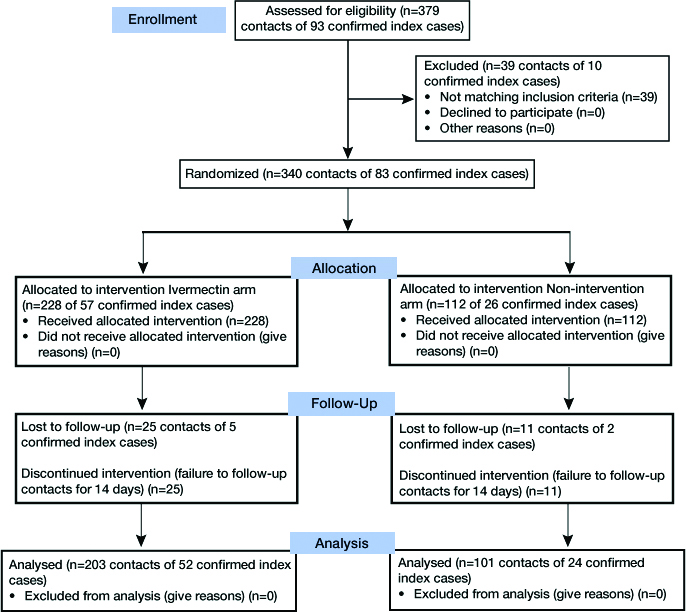
Comparison between ivermectin arm and non-intervention arm regarding basic characteristics.
| Basic characteristics | Ivermectin arm (N=203) | Non-intervention arm (N=101) | Test | p-value |
|---|
| No. | % | No. | % |
|---|
| Gender |
| Male | 106 | 52.2% | 50 | 49.5% | 0.199a | 0.656 |
| Female | 97 | 47.8% | 51 | 50.5% |
| Age (years) |
| Mean±SD | 39.75±14.93 | 37.69±16.95 | -1.357b | 0.175 |
| Median (Range) | 38 (16-94) | 35 (16-78) |
| Any co-morbidity |
| Absent | 156 | 76.8% | 75 | 74.3% | 0.248a | 0.619 |
| Present | 47 | 23.2% | 26 | 25.7% |
aChi-square test; bMann-Whitney U test
Percentages of common comorbidities encountered in the two investigated groups.
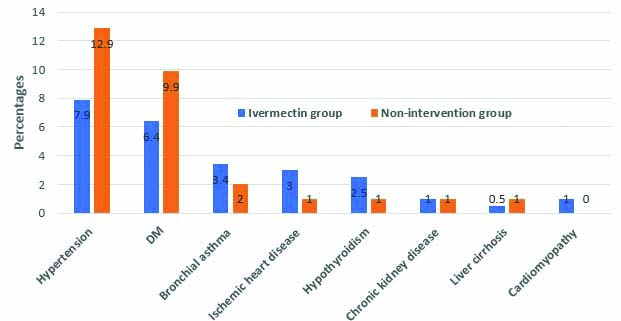
As regard index cases, there were 9 (11.8%) mild, 44 (57.9%) moderate and 23 (30.3%) severe cases. In ivermectin group, 14 (6.9%) were contacts of mild index cases; 135 (66.5%) contacts of moderate index cases; and 54 (26.6%) in contact with severe index cases. In non-ivermectin group, 20 (19.8%) were contacts of mild index cases, 43 (42.6%) contacts of moderate index cases, and 38 (37.6%) contacts to severe index cases [Table/Fig-4]. The protection rate was highly significant whatever the severity of index cases with p-values of 0.001, <0.001 and <0.001 for mild, moderate and severe cases, respectively.
Columns showing percentages of severity of the disease in index cases in the two groups.
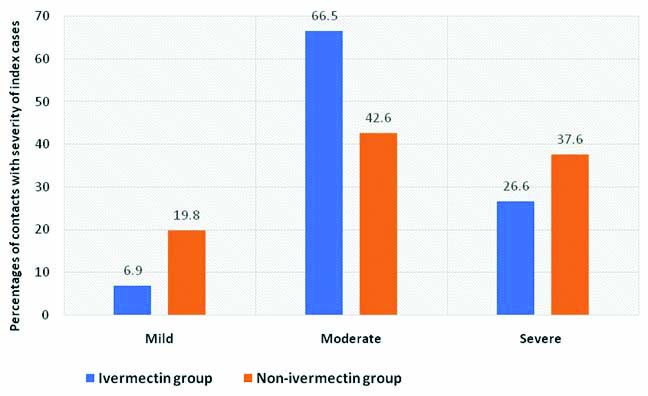
Fifteen (7.4%) contacts developed COVID-19 in the ivermectin arm compared to 59 (58.4%) in the non-intervention arm, all of them were symptomatic, according to the study protocol. The difference was highly significant (p<0.001) [Table/Fig-5]. In ivermectin group, there were 8 (53.3%) mild, 6 (40%) moderate and 1 (6.7%) severe cases; while in the non-ivermectin group, there were 31 (52.5%) mild, 21 (35.6%) moderate and 7 (11.9%) severe cases [Table/Fig-6]. The difference between the severity of contacts who developed the diseases was non-significant difference in both groups (p=0.834).
Comparison between ivermectin arm and non-intervention arm regarding outcome.
| Outcome | Ivermectin arm (N=203) | Non-intervention arm (N=101) | Test | p-value |
|---|
| No. | % | No. | % |
|---|
| Symptoms |
| Absent | 188 | 92.6% | 42 | 41.6% | 95.351a | <0.001 |
| Present | 15 | 7.4% | 59 | 58.4% |
| Days until symptoms |
| Mean±SD | 3±1.30 | 4.13±1.78 | -2.391b | 0.017 |
| Median (Range) | 2 (2-6) | 4 (2-10) |
| 2 days | 8 | 53.3% | 12 | 20.3% | 10.150a | 0.118 |
| 3 days | 2 | 13.3% | 13 | 22% |
| 4 days | 3 | 20% | 11 | 18.6% |
| 5 days | 1 | 6.7% | 13 | 22% |
| 6 days | 1 | 6.7% | 1 | 1.7% |
| 7 days | 0 | 0 | 8 | 13.6% |
| 10 days | 0 | 0 | 1 | 1.7% |
| CT suspect |
| Negative | 7/14 | 50% | 30/58 | 51.7% | 0.013a | 0.908 |
| Positive | 7/14 | 50% | 28/58 | 47.3% |
| CBC suspect |
| Negative | 2/14 | 14.3% | 5/58 | 8.6% | 0.412a | 0.523 |
| Positive | 12/14 | 85.7% | 53/58 | 91.4% |
| Protection rate |
| No protection | 15 | 7.4% | 59 | 58.4% | 95.351a | <0.001 |
| Protection | 188 | 92.6% | 42 | 41.6% |
aChi-square test; bMann-Whitney U test; p<0.05 is significant
Columns showing percentages of contacts who developed COVID-19; the total in the two groups and percentages of severity of disease in both groups.
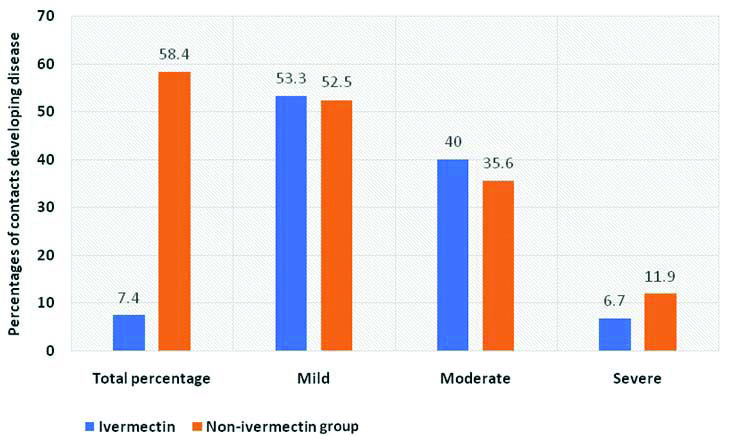
There was an insignificant linear correlation between contact time in days and number of contacts that developed COVID-19 (r=0.141; p=0.421). The appropriate forecasting for number of contacts that developed COVID-19 based upon contact time in days was quadratic model [Table/Fig-7].
Scatter plot shows relationship between contact time in days and number of contacts that developed COVID-19; dashed line represents best fitted line (quadratic model).
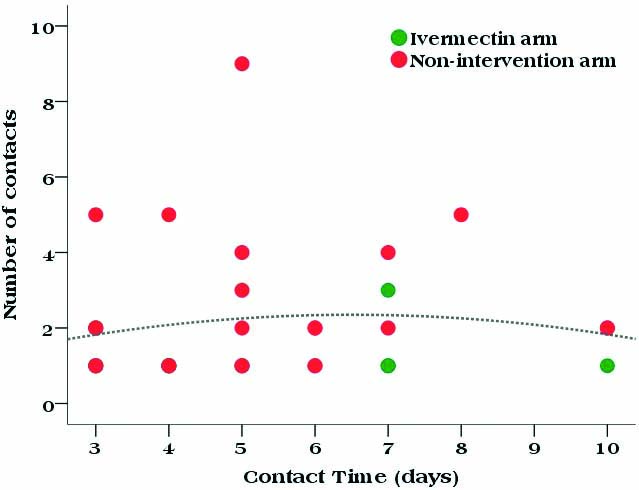
The median (range) days for developing the disease was 2 (2-6) in ivermectin group compared to 4 (2-10) in the non-intervention group; the difference was significant (p<0.017) [Table/Fig-5]. Ten contacts (66.6%) developed symptoms in first three days in ivermectin group, and none developed it after 6 days. In the non-intervention arm, 25 (42.3%) developed symptoms in the 1st 3 days and continued to the 10 days.
HRCT of the chest was performed in 14 out 15 contacts and in 58 of the 59 contacts who developed symptoms in ivermectin and non-intervention groups, respectively [Table/Fig-5]. The missed one case in each arm had symptoms and positive RT-PCR without other investigations.
It was noticed that 7.4% contacts developed diseases in ivermectin group; while they were 58.4% in non-intervention group. Contacts tend to be infected when the index case was severe; 14.8% and 71.1% in both groups, respectively [Table/Fig-8]. The protection rate for ivermectin was more prominent in contacts less than 60-year-old (6.2% infected compared to 58.7% if non-intervention), but still effective in elder than 60 years (16% infected compared to 55.6% if non-intervention). The protection was high in both uni- and multivariate analysis (OR: 12.533 (7.408-21.205), and 11.445 (4.444-29.475), respectively). Ivermectin showed a very highly significant role in the protection of SARS-CoV-2 infection [Table/Fig-9]. It had an OR of 12.533 and 11.445 when compared to non-intervention in both univariate and multivariate models, respectively. Ivermectin protection was not affected by gender or comorbidities in multivariate model.
Comparison between ivermectin arm and non-intervention arm regarding protection rate stratified by basic characteristics.
| All patients | | Protection rate | Testa | p-value |
|---|
| Ivermectin arm | Non-intervention arm |
|---|
| All patients | | 92.6% | 41.6% | - | - |
| Index case severity | Mild | 92.9% | 35% | 11.381 | 0.001 |
| Moderate | 95.6% | 55.8% | 42.666 | <0.001 |
| Severe | 85.2% | 28.9% | 29.928 | <0.001 |
| Age | ≤60 | 93.8% | 41.3% | 91.514 | <0.001 |
| >60 | 84% | 44.4% | 5.320 | 0.034 |
| Gender | Male | 94.3% | 42% | 53.482 | <0.001 |
| Female | 90.7% | 41.2% | 42.278 | <0.001 |
| Any co-morbidity | No | 95.5% | 45.3% | 77.474 | <0.001 |
| Yes | 83% | 30.8% | 19.899 | <0.001 |
| DM | No | 94.7% | 42.9% | 96.308 | <0.001 |
| Yes | 61.5% | 30% | 2.253 | 0.214 |
| HTN | No | 93% | 44.3% | 81.372 | <0.001 |
| Yes | 87.5% | 23.1% | 12.272 | <0.001 |
aChi-square test; p<0.05 is significant)
Predictors for COVID-19 protection.
| Univariate model | Multivariate model |
|---|
| OR (95%CI) | p-value | OR (95%CI) | p-value |
|---|
| Arm |
| Ivermectin | 12.533 (7.408-21.205) | <0.001 | 11.445 (4.444-29.475) | <0.001 |
| Non-intervention | Reference | | | |
| Index case severity | | <0.001 | | 0.018 |
| Mild | 1.429 (0.722-2.828) | 0.306 | 1.257 (0.486-3.247) | 0.637 |
| Moderate | 6.120 (4.010-9.341) | <0.001 | 2.816 (1.355-5.851) | 0.006 |
| Severe | Reference | | | |
| Age |
| Age ≤60 years | 3.154 (2.386-4.169) | | | |
| Age >60 years | Reference | | | |
| Gender |
| Male | 3.457 (2.373-5.036) | <0.001 | 0.836 (0.437-1.600) | 0.588 |
| Female | Reference | | | |
| Any co-morbidity |
| Absent | 3.812 (2.774-5.239) | <0.001 | 2.222 (0.967-5.108) | 0.060 |
| Present | Reference | | | |
OR: Odds ratio; 95% CI: 95% Confidence interval
With regard to the ivermectin side effects, they were mild symptoms; and reported in 11 (5.4%) contacts. These were diarrhea in 3 (1.5%) contacts, nausea in 2 (1%), fatigue in 2 (1%), sleepiness in 1 (0.5%), abdominal pain in 1 (0.5%), heart burn in 1 (0.5%), tingling and numbness in 1 (0.5%) and lastly burning sensation in 1 (0.5%). There was an overlap of symptoms in one case i.e., one case showed more than one symptom. On comparing all side effects in ivermectin arm to those who did not receive ivermectin, the difference was significant (p=0.018).
Discussion
Worldwide, according to the WHO, the monthly rise of SARS-CoV-2 infection was 2844491 in May, 4250438 in June and 6920633 in July, 2020. Still, there is a high incremental increase in number of cases over time (https://www.who.int/emergencies/diseases/novel-coronavirus-2019/situation-reports) [14]. The pandemic is still far away from regression or control. At the same time, vaccine, or specific antiviral treatment is not available until now. Both of them may need a lengthy time to be invented, preclinically and clinically examined, approved and widely produced. Drug repurposing is the best possible time-worthy avenue for combating this emergent infection. Many repurposed drugs have been tried for treatment and only Hydroxychloroquine (HCQ) for prophylaxis. However, HCQ has failed in chemoprophylaxis for persons on long term use of it for other causes and when used intentionally for such purpose [15,16].
To our knowledge, no previous published studies were found to use ivermectin in the chemoprophylaxis of COVID-19. The present study was started based on the work of Caly L et al., who found that Ivermectin can inhibit SARS-CoV-2 in vitro with 99.98% reduction of viral RNA in 48 hours with a single dose of 5 μM ivermectin [9]. They suggested that ivermectin could act through inhibition of IMPα/β1-mediated nuclear import of viral proteins. This dose is more than 30 times the FDA-approved dose for other causes (150-200 mcg per kg). We hypothesised that this small dose in comparison to the in vitro dose could be sufficient to inhibit a possible invading or low viral load in close family contacts of COVID-19 patients. Follow-up of the present study participants was done for 14 days. This is depending on documented incubation period of COVID-19 that ranges from one to 14 days, with a mean of 5-6 days [13].
Among 203 asymptomatic close family contacts who received ivermectin, only 15 (7.4%) were noticed to develop the infection. While, in 101 contacts who didn’t use ivermectin, 59 (58.4%) developed the disease. The protection was noticed to be of high values in both uni- and multivariate analysis. This means a R0 (basic reproduction number: the average number of secondary infections produced by a typical case of an infection) of 0.3 in ivermectin group and 2.46 in the non-ivermectin group. The study was performed in close family contacts only as others such as those in work were not included due to the difficulty of tracing them. In Egypt, families are in close relation. Most of families live in the same house or in a near-by house with almost daily gatherings and visits. All the studied contacts were first degree relatives including their husbands, wives, brothers, parents and their off-springs. Ivermectin reduced significantly the probability that a contact can catch the disease. This means that it may help as a powerful efficacious pre- and post-exposure chemoprophylaxis management of COVID-19. The reproduction number for SARS-CoV-2 has been documented in the range of 2-6 worldwide [17]. In the close contacts, Wang Z et al., reported 30% positive RT-PCR with infection rate 38% in one contact, 50% in 2 contacts and 31% in 3 contacts; their study included adults and children with total of 155 contacts [18]. In their study, when children were excluded, 60% males and 58% females were confirmed cases. In the current study only adults aging ≥16-year-old were included. A secondary infection rate of 58.4% was seen in non-ivermectin group (of 101 contacts). In contrary, second attack rate in household close family contacts was 16.3% in China [19]. This study was performed during the lockdown that resulted in mitigation of new cases in that country.
As the R0 is higher than one, the pandemic is continuous and propagating, while when it is less than one, the spread is rolling down and is to be limited [20]. In the current work, the R0 for the close family contacts who received ivermectin was again 0.3. This means that ivermectin could be a promising rescue widely available drug to mitigate COVID-19 pandemic.
Ivermectin is a safe drug. Although the present study just included only adults aged 16 years or more, it is also safely be used in children with weights less than 15 kg [21]. Since 1987, a major pharmaceutical company donated with 1.4 billion doses to eradicate onchocerciasis; and another one with 1.2 billion treatments for control of lymphatic filariasis with high safety profile [22]. Even in high doses up to 120 mg once a day, it still has its wide safety and tolerability. The most common previously documented side-effects were headache, nausea, dizziness and rash [23]. In this work, the authors used a fasting dose of 200-300 μg/kg of ivermectin that is repeated 48 hours later to keep a longer body and lung level of the drug for contacts who were either previously exposed or would be exposed. It was safe, as the side effects of the drug were noticed in 5.4% of participants. They included diarrhea, nausea, heart burn, abdominal pain, tingling, burning sensation, fatigue, and sleepiness. These side effects were mild and didn’t necessitate stopping the drug or its withdrawal from the study. Although very rare, the most feared side effects of ivermectin is the stimulation of pathway in the brain with ataxia, psychosis and convulsions [24]. None of such adverse effects was observed in the present work. On contrary of the current work about the importance of ivermectin in its use as a COVID-19 prophylaxis as well as the previous studies stating its efficacy as a therapeutic in vivo study of animal models [25], Momekov G and Momekova D denied any consideration for the drug as a broad antiviral effect despite its proven effect in vitro studies [26].
The protection rate for the ivermectin group was 92.6% with lower but highly significant protection of 85.2% when the index case was severe. This is expected, as more severe the case is, the higher the viral load and viral shedding and infectivity increases. The viral load in severe cases was nearly 60 times than that of mild cases [27]. The protection in participants without comorbidities was higher than those with comorbidities, especially DM then HTN. Comorbidities are risk factors for all COVID-19 bad outcome measures first in the list is HTN and DM, followed by cardiovascular and chronic lung diseases [28]. All new cases in the ivermectin group occurred in the first 6 days of starting ivermectin; and most of them (86.7%) in the first 4 days; while in non-intervention group 61% happened to be in the first four days and still newly developing symptoms up to the 10th day of observation. This indicates the possibility that uses of ivermectin might prevent new infections and attenuate the course of asymptomatic or preclinical cases.
Limitation(s)
Limitations of the current work could be firstly, due to the small numbers used for the non-intervention group. This was attributed to the realisation that the no-intervention is hazardous after evaluating the contacts of first 24 index cases in both arms. Second, is the low rate of RT-PCR done in contacts with symptoms. This is due to the problems with performing the procedure in both mild-moderate cases and contacts as per protocol of management in Egypt [2]. At the same time, no RT-PCR for SARS-CoV-2 was performed to any asymptomatic contacts, which might in theory neglect the asymptomatic patients. But we assume that such limitation didn’t affect the results, as it included both groups investigated in the study. Third, is the used dose of ivermectin is empirical, whether larger and more frequent doses may carry more protection rates, or smaller doses with one dose only may have the same efficacy. This might be elucidated in further work. Fourth, is that there was exclusion of contacts other than the asymptomatic close family contacts. At the same time there was no study of living conditions and degree of density in people at home with index cases, smoking and employment of contacts. The wide scale coverage for all contacts for an index case may provide a better scene of the true role of ivermectin as a weapon to fight COVID-19 pandemic. Fifth, no contact less than 16-year-old was included. Although the course in children is almost benign, but they may form a silent pool of the infection that may infect elderly with grave sequences.
Conclusion(s)
Ivermectin is suggested to be a promising effective chemoprophylactic drug against COVID-19. Ivermectin is inexpensive, available and quite safe drug. As this is the first report regarding use of ivermectin in COVID-19 prophylaxis, it is very appropriate to promptly and rigorously study this drug further.
aChi-square test; bMann-Whitney U test
aChi-square test; bMann-Whitney U test; p<0.05 is significant
aChi-square test; p<0.05 is significant)
OR: Odds ratio; 95% CI: 95% Confidence interval